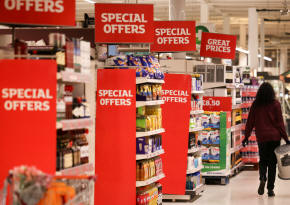Savings and algorithms: UK supermarkets battle cost of living crisis
 Send a link to a friend
Send a link to a friend
 [June 30, 2022] By
James Davey [June 30, 2022] By
James Davey
LONDON (Reuters) - Facing the toughest
economic conditions in decades, Britain's supermarkets are cutting
product ranges, searching for cost savings and patrolling each other's
stores to check prices and products as they try to stay one step ahead.
Like retailers across the world, UK grocers including market leader
Tesco and No. 2 Sainsbury's are struggling with the soaring cost of
supplies, a shortage of key products and workers, and cash-strapped
consumers.
But they enter the downturn on the back of an already lengthy period of
cost cutting due to fierce competition, forcing them to look for new
ways to make savings while increasingly using data to predict customer
reactions to change.
"I spend a lot of time in our competitors' (stores), all of the team do
too, we're constantly looking at what they're doing," Sainsbury's CEO
Simon Roberts told Reuters.
While passing on some price rises to customers and taking a hit to
profit margins themselves, supermarkets are fighting to limit the pain
for consumers on their most important lines, like fresh fruit and
vegetables, meat, fish and poultry.

"They'll all be looking at their relative performance and their relative
price position like never before, because that's in the end what counts,
their relative position to everybody else on price," said one grocery
industry veteran, speaking on condition of anonymity.
Tesco and Sainsbury's are both matching prices on key items with
German-owned discounter Aldi, seen as the low-price benchmark.
Prices are rising after the war in Ukraine restricted supplies of
sunflower oil and boosted wheat and animal feed prices - pushing up the
cost of meat, dairy and bakery products. Soaring energy and fuel prices,
as well as increased labour and transport costs, have added to the mix.
UK grocery inflation hit 8.3% in June, a 13-year high, according to
market researcher Kantar, forcing shoppers to cut back and buy cheaper
ranges. U.S. bank Citi said UK food price inflation could hit 20% early
next year.
RANGES
One focus for supermarkets is reducing the range of products they offer,
with their ability to sell multiple types of, for example, olive oil,
beans or toilet roll no longer seen as a priority for customers.
While supermarkets sought simplification before, the quest for new
savings means they are attacking it with renewed vigour, as focusing
their buying power allows them to get better terms.
In the last year, Tesco reduced the number of lines it sold of dairy
alternatives, such as oat and almond milk, by 47%, leading to a 4%
improvement in availability in retained lines.
Similarly, a 19% reduction in the amount of yoghurt lines led to an 11%
improvement in availability.
Privately-owned Asda said it reduced its food range by 12.5% last year,
primarily by removing duplicate products. However, the introduction of
more budget products meant its range has increased by 2.5% this year.
[to top of second column] |

A employee walks inside a Sainsbury?s supermarket in Richmond, west
London, Britain, June 27, 2022. Picture taken June 27, 2022.
REUTERS/Henry Nicholls

The approach fits with steps taken by French food giant Danone, the world's
biggest yoghurt maker, which is cutting the variety of products it sells,
including the number of flavours and packaging size options.
"If you halve your range in an area then the half that you've got left instantly
becomes twice as fast selling on average, assuming you haven't lost a customer
on what you've discontinued," said the grocery industry veteran.
"And if you're moving from two suppliers to one supplier then your terms with
that supplier can improve dramatically."
ALGORITHMS
Supermarkets can reduce ranges more effectively than in the past by using
customer data and analytics to predict whether shoppers will accept an
alternative brand or not.
"The role that algorithms play now in understanding the commercial model is
super important," said Sainsbury's Roberts.
"We've got some more innovation but also we've trimmed certain categories as
well," he said.
With Britain's supermarkets operating on margins of only around 3%, they also
need to make savings across the business.
"If we're going to invest 500 million pounds on bringing prices down, or 100
million pounds this year, 200 million pounds over two years, investing in
colleagues, then we have to find efficiencies," said Roberts.
Market-leader Tesco has leveraged highly publicised price matching offers and a
popular "Clubcard Prices" loyalty scheme to agree good terms with suppliers,
enabling it to ensure that where it has to raise prices it tries "to ensure it
is a little bit less and a little bit later than the rest of the market," it
says.

But tensions with some suppliers are rising. On Wednesday, U.S. food giant Kraft
Heinz stopped supplying some products to Tesco after the grocer resisted higher
prices.
While, like Sainsbury's, Tesco has warned of a hit to profits this year,
industry data shows it is consistently outperforming rivals on a sales value
basis, along with discounters Aldi and Lidl.
"Our ambition is to outperform the market, we can't control the environment,
which of course remains incredibly challenged and frankly looks like it's
getting more challenging," CEO Ken Murphy said.
(Reporting by James Davey; Editing by Mark Potter)
[© 2022 Thomson Reuters. All rights
reserved.]This material may not be published,
broadcast, rewritten or redistributed.
Thompson Reuters is solely responsible for this content. |